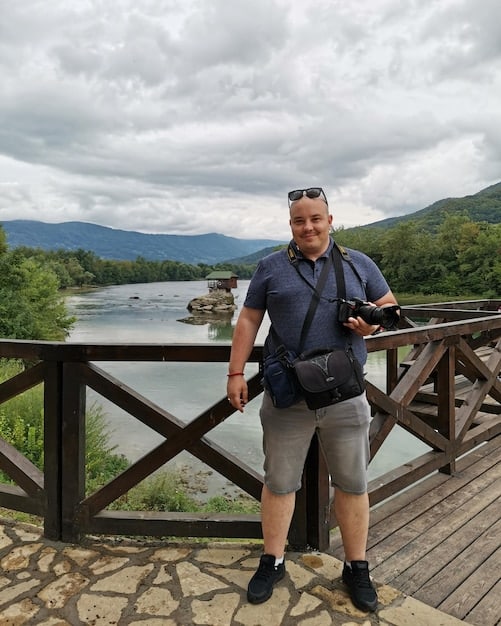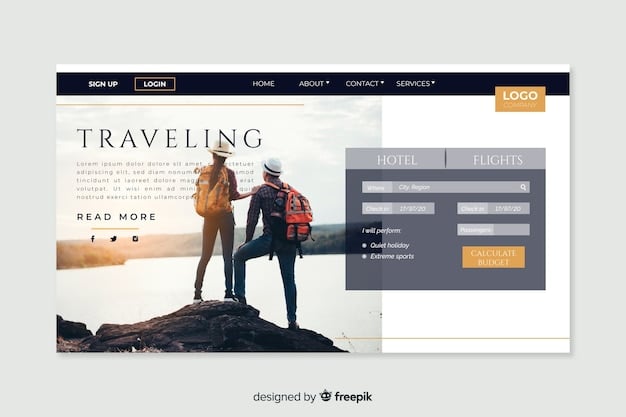How to Build a Travel Journalist Brand in a Competitive Market

Building a strong personal brand as a travel journalist in a competitive market requires crafting a distinctive identity, leveraging social media, networking strategically, securing consistent publication opportunities, and adapting to the evolving media landscape.
In today’s crowded media landscape, establishing a strong personal brand is crucial for travel journalists. Learning how to build a strong personal brand as a travel journalist in a competitive market isn’t just about gaining visibility; it’s about crafting a unique identity that resonates with audiences and sets you apart from the competition.
Defining Your Niche and Target Audience
Before diving into the specifics of brand building, it’s essential to identify your niche within travel journalism and understand your target audience. This clarity will inform your content strategy, voice, and overall brand positioning.
Identifying Your Unique Angle
What makes your perspective on travel different? Define your area of expertise or passion—adventure travel, sustainable tourism, luxury experiences, budget backpacking, food tourism, or cultural immersion. Hone in on what makes you, you.
Understanding Your Audience
Who are you trying to reach with your stories? Consider their demographics, interests, and travel habits. Tailoring your content to resonate with your target audience will increase engagement and build a loyal following.
- Conduct audience research through surveys and social media polls.
- Analyze the demographics of your existing audience (if any).
- Monitor industry trends to understand what topics are currently resonating.
By focusing on a specific niche and catering to a well-defined audience, you can create content that resonates deeply and establishes you as an authority in your field. This focused approach is the foundation for a compelling personal brand.
Crafting a Compelling Online Presence
Your online presence is the digital face of your personal brand. Creating a professional website, establishing a consistent social media strategy, and showcasing your best work are essential steps in building a strong and recognizable brand.

Building a Professional Website
Your website serves as a central hub for your work. Include a portfolio of your published articles, a blog with your original content, an “About Me” page with your bio and credentials, and contact information. A professional design is paramount.
Leveraging Social Media Platforms
Choose social media platforms that align with your target audience and brand identity. Share your articles, engage with followers, and participate in relevant conversations. Consistency is key.
- Develop a content calendar to ensure a steady stream of posts.
- Use high-quality visuals to capture attention.
- Engage in meaningful conversations with your followers.
Showcasing Your Best Work
Your portfolio should be a curated selection of your strongest articles and published features. Highlight your versatility, storytelling ability, and expertise in your niche. Ensure potential clients and editors can easily access your best writing and photography by showcasing your best content.
A well-crafted online presence establishes your credibility and makes it easier for potential clients, editors, and readers to discover your work. It’s the cornerstone of your personal brand.
Networking and Building Relationships
In the competitive world of travel journalism, building strong relationships with editors, fellow journalists, and industry professionals is essential for career advancement and brand building. These networks can provide opportunities, support, and visibility.
Attending Industry Events
Travel conferences, media events, and workshops offer valuable opportunities to meet editors, potential clients, and like-minded professionals so attend them and hand out business cards.
Engaging with Fellow Journalists
Connect with other travel journalists online and in person. Collaborate on projects, share industry insights, and offer mutual support. Genuine connection is key to growing your network.

Reaching Out to Editors
Identify editors who publish content in your niche and reach out with tailored pitches or introductions. Follow their guidelines and demonstrate your understanding of their publication’s style.
- Research the editor’s past work and interests before making contact.
- Personalize your outreach emails to demonstrate your genuine interest.
- Follow up politely if you don’t receive a response immediately.
Building a strong network takes time and effort, but the long-term benefits—increased opportunities, support, and enhanced credibility—are well worth the investment.
Consistent High-Quality Content Creation
Creating and consistently publishing engaging content is essential for building your travel journalist brand, helping to establish you as a thought leader.
Commitment to a regular article publishing schedule
Commitment to quality content and consistent publication demonstrates your expertise while keeping your audience engaged and returning for more.
Originality and Engaging Storytelling
What is your unique perspective you are bringing? Your audience will value your originality and ability to captivate your audience. Focus on well-crafted narratives.
- Diversify your content by experimenting with different formats, such as long-form articles, short blog posts, photo essays, and videos.
- Craft compelling headlines that grab readers’ attention.
- Use high-quality images and multimedia elements to enhance your storytelling.
By consistently delivering high-quality, engaging content, you can establish yourself as a go-to source for travel information and inspiration, building a loyal following and enhancing your brand’s reputation.
Monetizing Your Brand
As your personal brand grows, it’s essential to explore ways to monetize your expertise and creativity. Diversifying your income streams can provide financial stability and independence.
Freelance Writing and Photography
Continue to pitch articles and photo essays to publications in your niche. Negotiate fair rates and build long-term relationships with editors. Your increased reputation can help you secure contracts.
Sponsored Content and Brand Partnerships
Collaborate with travel brands to create sponsored content for your website and social media channels. Ensure that the partnerships align with your brand values and resonate with your audience.
Speaking Engagements and Workshops
Leverage your expertise to offer speaking engagements, workshops, and online courses on travel writing, photography, or specific travel topics. The demand will be there.
- Identify relevant conferences and events to pitch your speaking services.
- Develop engaging workshop materials that provide practical value to attendees.
- Create online courses that allow you to reach a global audience.
Monetizing your brand requires a strategic approach, balancing income generation with the need to maintain your authenticity and credibility. Choose opportunities that align with your values and enhance your brand reputation.
Adapting to the Evolving Media Landscape
The media and travel industry is always in flux. Embrace innovation, experiment with new formats, and stay ahead of the curve to ensure that your brand remains relevant and competitive.
Embracing New Technologies
Explore emerging technologies such as virtual reality, augmented reality, and artificial intelligence to create immersive and interactive travel experiences. Be ahead of the field with your journalistic expertise.
Experimenting with New Formats
Vary your content by experimenting with different formats, such as podcasts, live streams, and interactive maps. This will set you apart and make you a leader when learning how to build a strong personal brand as a travel journalist in a competitive market.
Staying Up-to-Date on Trends
Continuously monitor industry trends, attend conferences, and read publications to stay informed about the latest developments in travel and media. Ensure you are always in the know.
Adapting to the evolving media landscape requires a commitment to lifelong learning, experimentation, and a willingness to embrace change. By staying ahead of the curve, you can ensure that your brand remains competitive and relevant in the years to come.
| Key Point | Brief Description |
|---|---|
| 🎯 Define Your Niche | Specialize in a specific travel area (e.g., adventure, luxury) to target a precise audience. |
| 🌐 Online Presence | Craft a professional website and use social platforms to showcase your work. |
| 🤝 Networking | Build relationships with editors and other journalists to gain opportunities. |
| ✍️ Quality Content | Consistently post quality, engaging content to build your brand’s authority. |
FAQ
▼
Consider your passions and expertise. Are you drawn to adventure, luxury, food, or culture? Specialize in what you know and love.
▼
Showcase your best published articles, blog posts, and photographs. Highlight your range of storytelling and include varied geographical diversity if applicable.
▼
Attend industry events, join travel writing communities, and connect on social media. Collaborate on projects to form connections, and share insights on mutual journeys.
▼
Aim for consistency but ensure its quality. A good start is publishing once a week and building up to having content available for all audience types.
▼
Freelance writing, sponsored content, speaking engagements, and affiliate marketing are routes. Choose options that match your brand and appeal to your audience.
Conclusion
Building a strong personal brand as a travel journalist in a competitive market requires a multifaceted approach. By defining your niche, crafting a compelling online presence, networking strategically, creating high-quality content, monetizing your brand, and adapting to the evolving media landscape, you can establish yourself as a respected and sought-after voice in the world of travel journalism.





